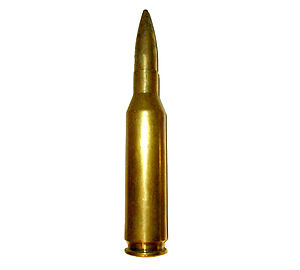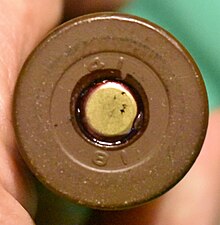14.5 × 114 mm
| 14.5 × 114 mm | ||||||||||||||||||||||||
|---|---|---|---|---|---|---|---|---|---|---|---|---|---|---|---|---|---|---|---|---|---|---|---|---|
 A 14.5×114 mm cartridge | ||||||||||||||||||||||||
| Type | Anti-tank rifle, anti-materiel rifle, heavy machine gun | |||||||||||||||||||||||
| Place of origin | Soviet Union | |||||||||||||||||||||||
| Service history | ||||||||||||||||||||||||
| In service | 1941–present | |||||||||||||||||||||||
| Used by | Soviet Union and successor states | |||||||||||||||||||||||
| Wars | WWII,Soviet–Afghan War,War on Terror,2011 Libyan civil war,Syrian Civil Warand many other conflicts | |||||||||||||||||||||||
| Production history | ||||||||||||||||||||||||
| Designed | 1939 | |||||||||||||||||||||||
| Specifications | ||||||||||||||||||||||||
| Case type | Rimless, bottleneck | |||||||||||||||||||||||
| Bullet diameter | 14.88 mm (0.586 in) | |||||||||||||||||||||||
| Land diameter | 14.50 mm (0.571 in) | |||||||||||||||||||||||
| Neck diameter | 16.5 mm (0.65 in) | |||||||||||||||||||||||
| Shoulder diameter | 25.50 mm (1.004 in) | |||||||||||||||||||||||
| Base diameter | 26.95 mm (1.061 in) | |||||||||||||||||||||||
| Rim diameter | 26.95 mm (1.061 in) | |||||||||||||||||||||||
| Rim thickness | 2.5 mm (0.098 in) | |||||||||||||||||||||||
| Case length | 114 mm (4.5 in) | |||||||||||||||||||||||
| Overall length | 155.80 mm (6.134 in) | |||||||||||||||||||||||
| Case capacity | 42.53 cm3(656.3gr H2O) | |||||||||||||||||||||||
| Rifling twist | 455 mm (1 in 17.91 in) | |||||||||||||||||||||||
| Maximum pressure | 360 MPa (52,000 psi) | |||||||||||||||||||||||
| Ballistic performance | ||||||||||||||||||||||||
| ||||||||||||||||||||||||
| Test barrel length: 1350 mm (53 inches) Source(s):Post WWII Ammunition Russian Ammunition Page | ||||||||||||||||||||||||
The14.5 × 114 mm(.57 calibre) is aheavy machine gunandanti-materiel riflecartridgeused by theSoviet Union,the formerWarsaw Pact,modern Russia, and other countries.
It was originally developed for thePTRSandPTRDanti-tank rifles,and was later used as the basis for theKPV heavy machine gunthat formed the basis of theZPU seriesanti-aircraft guns that is also the main armament of the BTR series ofarmoured personnel carriersfrom theBTR-60to theBTR-80and for heavy anti-materielsniper rifles.
Cartridge dimensions
[edit]The 14.5 × 114 mm has 42.53ml(655grainsH2O) cartridge case capacity. The exterior shape of the case was designed to promote reliable case feeding and extraction inbolt-action rifles,semi-automatic rifles,andheavy machine gunsalike, under extreme conditions.
14.5×114 mm maximum cartridge dimensions. All dimensions in millimetres (mm).
Americans define the shoulder angle at alpha/2 = 22.5 degrees. The commonriflingtwist ratefor this cartridge is 455 mm (1 in 17.91 in), 8 grooves, ⌀ lands = 14.50 mm, ⌀ grooves = 14.95 mm.
According to the official guidelines, the 14.5 × 114 mm case can handle up to 360 MPa (52,213 psi) piezo pressure. InC.I.P.regulated countries every rifle cartridge combo has to beproofedat 125% of this maximum C.I.P. pressure to be certified for sale to consumers.
Ammunition types
[edit]




- BS:Armour-piercingincendiaryoriginal anti-tank round. The projectile weighs 64.4 g (2.27 oz) and is 51 mm (2.0 in) long with a 38.7 g (1.37 oz) core oftungsten carbide[1]with 1.8 g (0.063 oz) of incendiary material in the tip. The overall round weighs approximately 200 g (7.1 oz) and is 155 mm (6.1 in) long. The projectile has a muzzle velocity of approximately 1,006 m/s (3,300 ft/s) and can penetrate 30–32 mm (1.2–1.3 in) of RHA steel at an incidence of 0 degrees at a range of 500 m (1,600 ft), or 40 mm (1.6 in) at a range of 100 m (330 ft).[2][3][4]
- B-32: Armour-piercing incendiaryfull-metal-jacketround with ahardened steelcore. Projectile weight is 64 g (2.3 oz) andmuzzle velocityis 1,006 m/s (3,300 ft/s). Armour penetration at 500 m (1,600 ft) is 32 mm (1.3 in) ofRHAat 90 degrees.
- BZT: Armour-piercing incendiarytracerfull-metal-jacket round with a steel core. Projectile weight is 59.56 g (2.101 oz) and muzzle velocity is 1,006 m/s (3,300 ft/s). Tracer burns to at least 2,000 m (6,600 ft).
- MDZ:High-explosive incendiarybullet of instant action. Projectile weight is 59.6 g (2.10 oz).
- ZP: Incendiary tracer round
Cartridges use lacquered steel cases and percussion primers. Some countries also use brass cartridge cases. The propellant consists of 28.8 g (1.02 oz) smokeless powder with seven tubes, designated as "5/7NA powder". Two different versions of bullet series are known, the earlier has a conventional bullet jacket with a boat-tail. These have a long engraving portion that causes considerable barrel wear. The newer bullet types have a smaller engraving portion with a rounder boat-tail and were used from about 1957 onward.
The cartridge has been manufactured in Bulgaria, China, Egypt, Hungary, Iraq, North Korea, Poland, Romania, Russia, and the formerCzechoslovakia.There are new Chinese armour-piercing types:[5]
- DGJ02: APIDS-T cartridges use 45 g (1.6 oz) tungsten penetrators, wrapped in discarding sabots (similar to the US militarySLAPcartridges) with dual colour tracers to aid ranging. The sabot splits and leaves the penetrator between 150 m (490 ft) and 200 m (660 ft) from the muzzle. It has a muzzle velocity of 1,250 m/s (4,100 ft/s) and is quoted as being able to penetrate 20 mm (0.79 in) of armour plate set at an angle of 60° at 1,000 m (3,300 ft).
- DGE02: APHEI cartridges weigh between 175 g (6.2 oz) and 188 g (6.6 oz). At 1,000 m (3,300 ft) it is quoted as having a 90 percent chance of being able to penetrate 15 mm (0.59 in) of armour plate set at 30°. At 300 m (980 ft) after penetrating a 2 mm (0.079 in) soft steel plate (representing an aircraft skin) it can further penetrate a 1.2 mm (0.047 in) thick steel plate producing 20 fragments. Upon explosion between 75 and 95 incendiary pieces are formed which have an 80% chance of igniting aviation fuel.
Chambered weapons
[edit]Anti-materiel rifles
- Anzio rifle
- Cadex CDX-X145
- Denel NTW-20
- Gepard M-3
- Istiglal IST-14.5
- Mambi-1 AMR
- PDSHP
- PTRS-41(anti-tank rifle)
- PTRD-41(anti-tank rifle)
- Shaher[6]
- Snipex T-Rex
- Snipex Alligator
- Truvelo 14.5×114mm
- Vidhwansak
- Şer rifle (home made anti-materiel rifle)[7]
Machine guns
- Slostin machine gun (heavy variant)
- KPV heavy machine gun
- Chinese Type 56 (KPV) and Type 58 (KPVT) heavy machine guns
- Type 02/QJG-02heavy machine gun[8]
Other
- ZPU anti-aircraft guns
- 2Kh35 inserted unified self-loading gun[9]
In addition, the Ukrainian "Horizon's Lord" sniper rifle fires a 12.7 × 114 HL round made by necking down a 14.5 × 114 mm cartridge case to accept a 12.7 mm /.50 BMG bullet.[10]
See also
[edit]References
[edit]- ^Pobedit-style alloy Re8 (РЭ8) containing 8% cobalt. Commonly described as a "cermet"in Russian sources.
- ^Chant, Christopher (1989).Air Defense Systems and Weapons: World AAA and Sam Systems in the 1990s.Brassey's Defence Publishers. p. 345.ISBN978-0-08-036246-5.
- ^Opposing Forces: Europe.Department of Defense, Department of the Army, Headquarters. 1977. pp. 1–5.
- ^"Armor",Volume 81 Issue 6. United States Armor Association. 1972. p. 43.
- ^Andrew, Martin (April 2012)."PLA Mechanised Infantry Division Air Defence Systems".Air Power Australia:1.
- ^"Iran unveils new tactical vehicle, sniper rifle".Tehran Times.Archived fromthe originalon 16 November 2012.Retrieved18 November2012.
- ^Kurdish 12.7mm Zagros and 14.5mm Şer Anti-Materiel Rifles,retrieved14 March2022
- ^"14.5 mm QJG 02 heavy machine gun (PR China)".Archived fromthe originalon 2 September 2010.Retrieved29 October2010.
- ^2Kh35 Inserted unified self-loading gun
- ^"MSN".MSN.
Further reading
[edit]- Koll, Christian (2009).Soviet Cannon: A Comprehensive Study of Soviet Arms and Ammunition in Calibres 12.7mm to 57mm.Austria: Koll. p. 91.ISBN978-3-200-01445-9.Archived fromthe originalon 19 October 2009.Retrieved21 November2009.

